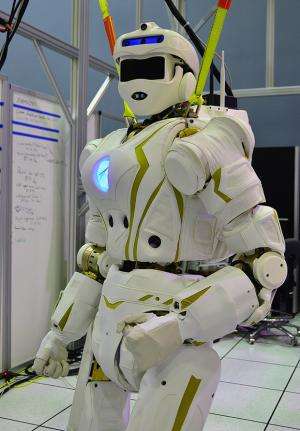December 11, 2013 weblog
Valkyrie steps forth as DARPA robotics contender

(Phys.org) —The clock is ticking for robot enthusiasts who are eager to see what happens on the big day, December 20, for the 17 teams competing in the Defense Advanced Research Projects Agency (DARPA) Robotics Challenge. The event scheduled for Dec. 20 and 21 in Florida is where the robots will be tested on the capabilities that would enable them to provide assistance in future natural and man-made disasters. On Tuesday, curiosity and expectations were ratcheted up significantly with the unveiling of NASA's Johnson Space Center entry, a humanoid robot called Valkyrie (R5). This is a 6-foot-two-inch, battery operated robot weighing 286 pounds with 44 degree of freedom. (The Valkyrie has seven degree of freedom arms, for example, with actuated wrists and six degree of freedom hands. Each hand has three fingers and a thumb.)
Valkyrie, as an entry in the DRC challenge, has to be something quite beyond a space robot; the challenge for the NASA team, as with all hopefuls in the DARPA challenge, is to present a robot that demonstrates critical improvements in what robots can do to help out in disaster relief efforts, when human intervention is unsafe and time is of the essence, such as nuclear power plant disasters, oil spills, and wildfires. That means the robots who compete need to be agile and responsive to move through disaster zones and do needed rescue tasks. In the words of DARPA, the Challenge itself was designed "to catalyze the robotics community to help mitigate the effects of future disasters."
The robots will need to prove capabilities in such tasks as walking over uneven terrain, climbing a ladder, and using tools.
The Valkyrie was built to take on the challenge by the NASA JSC team in partnership with the University of Texas and Texas A&M, and with funding from the state of Texas. A detailed report in IEEE Spectrum reveals the level of effort they put into Valkyrie: Two shifts totaling 22 hours a day, from 7 am through 5 am the next morning, with the end result of a robot designed and built in nine months.
NASA JSC team leader Nicolaus Radford said that one of the concerns in building this robot was to make sure they could replace components quickly. A 2kWh battery stored in the robot's backpack can be replaced with a fresh one in minutes. They also designed the robot's limbs as removable parts that can be swapped out for new parts in minutes. What's more, they designed the left and right arms to be identical in construction, so that right and left arms can be swapped if needed.
The robot, which is battery-powered and operates without a tether, will compete with robots from other teams to show how well it can complete designated physical tasks, the kinds of tasks first responders would confront in real disasters. Human operators and their machines will be assessed according to such abilities as autonomous perception and decision-making, mobility, strength and dexterity. In turn, the IEEE Spectrum nailed where Valkyrie needs to compete on design and build: Valkyrie will need to show an impressive amount of "embedded intelligence."
Not surprisingly, Valkyrie will enter the competition with lots of onboard computing. Sensors are generously spread all over Valkyrie. There are cameras and LIDAR (a remote sensing method, LIDAR stands for Light Detection and Ranging) in the head, cameras in the abdomen, forearms, knees and feet. Valkyrie's clothing consists of panels of fabric-wrapped foam armor which can protect Valkyrie from falls and impacts. The clothing was built on site by a dedicated design staff.
Beyond December 20, Radford is looking to NASA's goals vis a vis the team's efforts thus far. "We want to get to Mars," he said. Likely NASA will send robots ahead of the astronauts, he added, and these robots will start preparing the way for the human explorers. When the humans arrive, the robots and humans will work together, building, laying foundations, in a tight relationship. He said that technologies such as Valkyrie will lead into the type of robotic systems that will one day play a role in the exploration of Mars. "The descendants of the NASA DRC entry," said a Team NASA JRC, "will undoubtedly play a key role in the future of planetary exploration and many of these team members will make sure that happens."
More information: www.darpa.mil/NewsEvents/Releases/2013/12/04a.aspx
© 2013 Phys.org



















